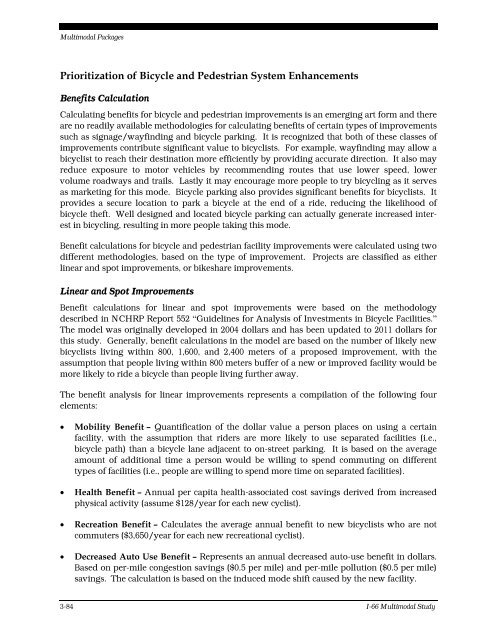I-66 Multimodal Study Final Report - Virginia Department of ...
I-66 Multimodal Study Final Report - Virginia Department of ...
I-66 Multimodal Study Final Report - Virginia Department of ...
- No tags were found...
Create successful ePaper yourself
Turn your PDF publications into a flip-book with our unique Google optimized e-Paper software.
<strong>Multimodal</strong> PackagesPrioritization <strong>of</strong> Bicycle and Pedestrian System EnhancementsBenefits CalculationCalculating benefits for bicycle and pedestrian improvements is an emerging art form and thereare no readily available methodologies for calculating benefits <strong>of</strong> certain types <strong>of</strong> improvementssuch as signage/wayfinding and bicycle parking. It is recognized that both <strong>of</strong> these classes <strong>of</strong>improvements contribute significant value to bicyclists. For example, wayfinding may allow abicyclist to reach their destination more efficiently by providing accurate direction. It also mayreduce exposure to motor vehicles by recommending routes that use lower speed, lowervolume roadways and trails. Lastly it may encourage more people to try bicycling as it servesas marketing for this mode. Bicycle parking also provides significant benefits for bicyclists. Itprovides a secure location to park a bicycle at the end <strong>of</strong> a ride, reducing the likelihood <strong>of</strong>bicycle theft. Well designed and located bicycle parking can actually generate increased interestin bicycling, resulting in more people taking this mode.Benefit calculations for bicycle and pedestrian facility improvements were calculated using twodifferent methodologies, based on the type <strong>of</strong> improvement. Projects are classified as eitherlinear and spot improvements, or bikeshare improvements.Linear and Spot ImprovementsBenefit calculations for linear and spot improvements were based on the methodologydescribed in NCHRP <strong>Report</strong> 552 “Guidelines for Analysis <strong>of</strong> Investments in Bicycle Facilities.”The model was originally developed in 2004 dollars and has been updated to 2011 dollars forthis study. Generally, benefit calculations in the model are based on the number <strong>of</strong> likely newbicyclists living within 800, 1,600, and 2,400 meters <strong>of</strong> a proposed improvement, with theassumption that people living within 800 meters buffer <strong>of</strong> a new or improved facility would bemore likely to ride a bicycle than people living further away.The benefit analysis for linear improvements represents a compilation <strong>of</strong> the following fourelements:Mobility Benefit – Quantification <strong>of</strong> the dollar value a person places on using a certainfacility, with the assumption that riders are more likely to use separated facilities (i.e.,bicycle path) than a bicycle lane adjacent to on-street parking. It is based on the averageamount <strong>of</strong> additional time a person would be willing to spend commuting on differenttypes <strong>of</strong> facilities (i.e., people are willing to spend more time on separated facilities).Health Benefit – Annual per capita health-associated cost savings derived from increasedphysical activity (assume $128/year for each new cyclist).Recreation Benefit – Calculates the average annual benefit to new bicyclists who are notcommuters ($3,650/year for each new recreational cyclist).Decreased Auto Use Benefit – Represents an annual decreased auto-use benefit in dollars.Based on per-mile congestion savings ($0.5 per mile) and per-mile pollution ($0.5 per mile)savings. The calculation is based on the induced mode shift caused by the new facility.3-84 I-<strong>66</strong> <strong>Multimodal</strong> <strong>Study</strong>
















